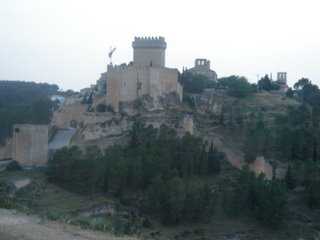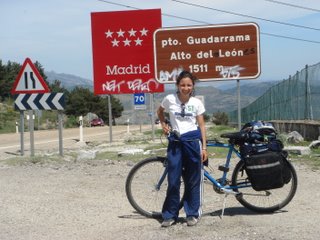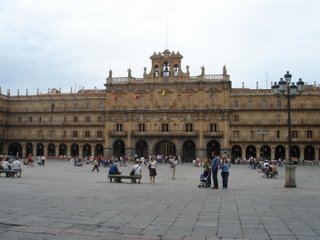Madrid-Tarancón/Cuenca
Trip dist: 84 kms. Trip time: 5 hrs, 39 mins. Tot dist: 1583 kms.
Or, how to save yourself 2 day's time without breaking the continuous kilometer count.
Or, quantum teleportation for beginners.
Ah, it was difficult leaving Madrid. Not for lack of will, mind you (since coming back from Aranjuez I discovered that part of the reason I dislike Madrid is because of its sounds as well: too noisy and stressful and too much shouting...blech), but what with the day trips that took longer than I wanted and, most importantly, the fact that it is actually, logistically, literally very difficult to leave, at least if you're on a bike. Similar to Lisbon, there are only freeways surrounding and linking Madrid to other places, so if you're on a bike you either have to take very long, confusing detours through rather sparse neighboring towns (the towns near Lisbon were nicely daisy-chained together, so the detour, though stressful because of traffic, at least did not significantly add to the kilometer count), or grit your teeth and climb onto the highway and hope for the best.
Anyway, added to the day's traffic stress was some rather strange encounters I had with people in little villages on the way. At the small town of Arganda, for instance, I was passing by the city center, and as the obvious road ended, a local policeman pointed me uphill along a narrow street that was a one-way in the direction opposite the one I was headed, so I jumped off the bike and started push-walking it on the (rather narrow, admittedly) sidewalk, for I was not planning on getting hit by cars coming down blind corners during city center midday chaos.
Well, it was not long before my people obstacle-avoiding came to the inevitable: two older ladies talking in the middle of the street taking up the whole of the narrow walkway, who as it happens, saw me approaching, and unlike most other people that saw me with the bike, seemed to decidedly and purposely stay put and keep chatting, this time, as I neared and overheard, about me, and "Sidewalks are not for bikes, what is she thinking?", etc. One of them moved aside to let me pass when I approached close enough to overhear, but the older one turned squarely to face me and extended her stance (which happened to be positioned exactly in the middle of the walkway) so as to occupy as much space as possible.
Naturally, I stopped, and looked at her quizzically.
"Would you let me pass, please?" I finally asked after a longish pause (I used the formal tone, which we have in Spanish to address older people and anyone you wish to show respect to).
"No," she said. "Why don't you take the street?"
I couldn't supress a chuckle at the ignorance of the obvious. The street was quite trafficed and a large van with difficulties navigating the narrow curved street was approaching us just as she finished saying that, though with her back towards it she may not have seen it.
"Because on the street the cars are heading the other way," I said. "Would you please permit me to pass?"
Can you believe it? "No," she said again. "I'm not letting you pass," then, turning towards the other woman she had been chatting with, exclaimed, "but look at her, look at how loaded her bike is!" (as if they'd never seen a bike before, or what?), and then, squaring herself again to me, stood bracedly as if she wanted to grip the sidewalk with the nails of her toes.
Now, mind you, it was a hot day, I had been riding for many kilometers, I was in a hurry to get to Tarancón, and in general, my personality admits no patience for these kinds of stupid power games. So I did what one does when confronted with a small inconvenience, an ant you brush away when it crawls on the back of your hand, in the path of life: I waited until the van had passed, and then got on the street as I circled around her and got back on the sidewalk behind her, avoiding her as if she were simply...an old tree stump.
{shrug}
It was not the only odd encounter of the day, as it turns out. I arrived in Tarancón, fortuitiously, ten minutes before the bus to Cuenca was scheduled to depart at quarter to six p.m.. The original plan, from back when I was in the U.S., was to bike to Cuenca on my way to Valencia from Madrid, but seing as how by now I was already quite behind schedule and biking to Cuenca would take one more day from Tarancón, plus crossing a set of mountains (a sierra, actually) on the way south, I figured best to head to Valencia directly and day-trip to Cuenca. Since I couldn't stand to stay in Madrid one day longer, I decided to day-trip from Tarancón instead, but again, my trusty
Let's Go guide claimed that Cuenca was worth staying the night, so on the ride to Tarancón I figured, that if I got there early enough, I would take the bus to Cuenca that same day, overnight in Cuenca, then return to Tarancón in the morning or afternoon and continue biking from there, thus leaving the biking trail chain unbroken.
Well, when I arrived to Cuenca, of course, the first thing I did was look for a hostel. And I found one, cheap, but the owners here too seemed to be afflicted with some strange behaviors: every time I asked them some detail about the room, my question was received with an exchange of glances between the two women attending, plus some supressed chuckles, before the answer came, curtly and with as few details as possible. This made me worry, so I asked for more details (is there hot water all the time, or only at certain hours? How much does the room cost? Would you like me to pay in advance, or later?, and finally, may I see the room?), with the same kind of reaction, glances and chuckles/smiles under the whiskers, yet upon seing the room nothing seemed amiss. It was clear also that there were no other guests staying the night and the hostel was fairly empty, so one would expect that they would be glad to have my business, but then when I told them I had a bike they claimed that they had no place to store it (even though the hostel owners clearly owned the whole of the building, which included a cellar, a hall, three floors, a restaurant, and a back patio), and maybe I should look for a room somewhere else. Even when I told them, no problem, I'll lock the bike on the street outside, more chuckles, this time not as supressed, followed, again with an outright encouragement to look for a room somewhere else.
What? Was I looking very strange or dirty from the long ride that day? No, not particularly. I had showered, as well, that morning, as I always do. Perhaps, dare I think this, no, but, you never now, am I, could it be, a bit too darkly tanned from the bike rides by now for these provincial mentalities (only a week ago in the news there was a big scandal because they found one hundred illegal immigrants---one hundred! stashed away somewhere in the Canary Islands. You should've seen the fuss it made on TV. Of course, when you compare and think that in the US you get thousands of illegal border crossings each day, this one-hundred number is but a teeny-weeny droplet in the sea!)? But why would this matter, when it was clear that I could afford the cost of the room (many times over, in fact)?
Or what is it then, that these people have so much of and can take for granted, that it enables them to afford not to give a damn about anyone else?
I don't know!
Anyway, there was a pleasant anecdote to this day, at least. As I was looking for a hostel, I happened to stop in front of one where three gentlemen in their late 40's or 50's were chit-chatting. As I dropped the kickstand on the bike and prepared to head inside to enquire about rooms, one of them said to me: "I saw you."
Now, these kinds of statements always confuse me, because it is obvious that anyone standing by the door of a place I'm approaching will see me long before I arrive, so the statement of the evident, that I had been seen before the moment of the affirmation, seemed to me quite unnecessary, unless the act of seeing itself were in this particular case remarkable or worthy of note, as in, they could not see me before, but now, due to some unusual circumstance, could, but I could not find any physical evidence of any prior visual impairment that could endow this conjecture with the faintest possibility.
"Oh?" said I, as I struggled to sort out the previous chain of tortuous but unproductive thoughts, also because, by this point, I was rather tired from just having pedalled up the 12% grade or so climb to the old part of the city of Cuenca, and was not in the best shape or mood for reasoning complicated statements like this one at the moment.
"Yeah," added another. "We just saw you a couple of hours ago, as you were biking the ascent to Tarancón!".
"Ah," said I, still not understanding the surprise in the tone of voice, for up until now the gentlemen had limited themselves to expressing to me the obvious. "Well, yes," I continued, as I reprised my decisive approach towards the hostel entrance, "I was in Tarancón just a few hours ago indeed."
"But wait!" said the first gentleman again in an effort to keep me from leaving just a few moments longer, "how did you bike so fast from there to here? It must be at least what, 65 kilometers!"
And there suddenly I understood, and couldn't supress a smile. Of course. They had seen me on a bike two hours before, 70 kilometers away, and now here I was, arriving shortly afterwards, still on a bike. At first glance, it would look a little bit analogous, if you were familiar with the concept, with quantum teleportation! Ha ha ha!! Yeah. Got it. "Nah," I said, as I relaxed my entire stance as I settled in for a longer, clearly more pleasant now, conversation. "Took the bus after arriving to Tarancón. Only 1 hour bus ride."
"Aaaah, of course!" said another, as he elbowed the first gentleman with his elbow. "You see?", and the relief at knowing that their senses hadn't been fooled was palpable, as the group dissolved into a series of chuckles.
"We're cycling too, you know," said the second man (and here it became clear why I had attracted the notice of them in the first place). From then on, it became a rather nice conversation, with some route comparing, they heading northwards in an extended ride through vineyards and mountains, tip and suggestion exchanging, and the like.
"Still," said the first man, "pumping up the hill towards Tarancón...tough, no?"
I shrugged. Nothing compared to the past 20 minutes of climb up to the Cathedral of Cuenca, I thought, but said nothing.
"Good biotins," said he.
"What?" said I.
"You have good biotins."
And at that point I realized with a chuckle, that it was probably the first time in my life, that I was being subtly flattered, not for the mysterious look deep inside my eyes, or my wit or personality or sense of humor, or even, God forbid,
a la construction-worker style, for my "*whistle* nice legs!", but, ha ha, for, of all things...nothing less than my apparently quality suitability as a biological specimen.
:D
Anyway, managed to cram some good sight-seing in the last few hours of daylight, and even caught, as the
Let's Go guide suggests, the hanging houses at sunset (see picture above). Cuenca reminds me a bit of Morocco's Moulay-Idriss: it is a city on a hill, with medieval labyrinthine streets, the views down to the town are similar (just replace the Mosques with churches and Cathedral) from the hillside streets, and it has a similar feel, living-wise: both cities seem quite poor. The
bridge of San Pedro, too (from where the picture above was taken), reminds me a bit of Thorton Wilder's short novel,
The Bridge of San Luis Rey. It was kind of cool hearing the wind and looking down into empty space from it. {shrug}
And then, reading some of the signposts on the history of the city it became clear why it had reminded me of Morocco: Cuenca, too, was founded by Moors. Neat, huh?








